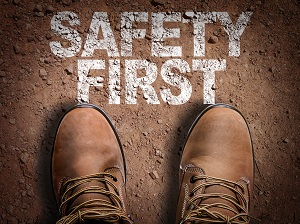Protecting workers from falls while working in attics can be challenging. Not all fall protection methods are suitable in all work situations and attic locations.

Working in attics, particularly low attics, can be difficult. Workers are exposed to many hazards which can increase the risk of falling, including:
- exposed nails
- cables and wires
- low-hanging rafters or cross-beams
- temperature extremes
- poor lighting
- truss chords hidden by deep insulation
All workers exposed to fall hazards must be trained to recognize fall hazards and know the procedures to follow to minimize these hazards to ensure their safety while working in attics.
Employers are responsible for providing a training program for all employees who might be exposed to fall hazards. The training program must train workers to recognize fall hazards and must also train workers on the procedures to be followed in order to minimize fall hazards.

While walking through or working in attics, workers must be protected from fall hazards. Depending on the condition of the attic, this may be achieved by:
- Eliminating the fall hazard (example: installing flooring)
- Using a passive fall protection system (example: guardrails)
- Using a fall restraint or fall arrest system
Workers can be injured if they fall through the ceiling to a lower level. Before work begins in the attic, the walking/working surfaces must be evaluated to determine if they have the strength and structural integrity to support workers safely. Using a piece of plywood or planking to stand on could improve footing.
OSHA Standard 1926.501(b)(13) The employer shall determine if the walking/working surfaces on which its employees are to work have the strength and structural integrity to support employees safely. Employees shall be allowed to work on those surfaces only when the surfaces have the requisite strength and structural integrity.
If the area around the plywood or planking is open, and the work area is 6 feet or more above a lower level, workers should be using fall protection. Scaffolds or ladders may also be used for attic work.
Planning for the use of fall protection equipment can help protect workers from falls while working in attics. Before beginning the job, identify fall protection needs. Survey the attic to determine what fall protection systems can be used. Plan ahead and have those systems in place before workers report to the job.

A Personal Fall Arrest System (PFAS) is a tool available to workers performing attic work. Always follow the manufacturer’s instructions on selecting, installing, and using PFAS components correctly.
A PFAS is designed to safely stop a fall before the worker strikes a lower level. The system includes three major components:
A. An anchorage to which the other components of the PFAS are rigged.
B. A full body harness worn by the worker.
C. A connector, such as a lanyard or lifeline, linking the harness to the anchorage. A rip-stick lanyard, or deceleration device, is typically part of the system.
Remember that workers must use full-body harnesses in fall arrest systems. Body belts can cause serious injury during a fall, and OSHA prohibits their use as part of fall arrest systems.
Anchorage connectors install on structurally sound components (such as a beam, wall, or roof) to create a secure tie-off point between the anchor and the lanyard on a personal fall protection system. There are many types of anchorage connectors available, each designed to offer a combination of features that fit a particular job.
OSHA Standard 1926.502(d)(15) Anchorages used for attachment of personal fall arrest equipment shall be independent of any anchorage being used to support or suspend platforms and capable of supporting at least 5,000 pounds per employee attached, or shall be designed, installed, and used as part of a complete personal fall arrest system which maintains a safety factor of at least two and under the supervision of a qualified person.
It may also be possible to provide safe anchorage down the length of an entire attic by properly installing an engineering horizontal lifeline. Always follow the manufacturer’s instructions or consult a qualified person when installing anchors to ensure that they are strong enough to hold the sudden weight of a falling worker.
With advance planning on new construction projects, some anchorage systems can be preinstalled before the trusses are lifted into position. This method permits workers to attach their lanyards to an anchorage immediately upon entering the attic space. When practical, consider leaving anchors in place. This can make the current job simpler and reduce the burden for attic workers in the future.

Fall restraint systems prevent falls by keeping the worker from reaching a fall hazard. While fall restraint systems are not mentioned in OSHA’s fall protection rules, OSHA will accept a properly utilized fall restraint system in place of a personal fall arrest system when the restraint system is rigged so that the worker cannot reach the fall hazard.
A fall restraint system is comprised of a body belt or body harness, an anchorage, connectors, and other necessary equipment. Other components typically include a lanyard and may also include a lifeline and other devices. A self-retracting lanyard is not appropriate for a fall restraint system unless the worker cannot reach the fall hazard when the lanyard is fully extended.
If properly used, a fall restraint system tethers a worker in a way that will not allow a fall of any distance. Fall restraint may be a viable way to provide fall protection in situations where there may be concerns about the adequacy of available anchorage points for fall arrest equipment. OSHA recommends that fall restraint systems have the capacity to withstand 3,000 pounds of force or twice the maximum expected force that is needed to restrain the worker from exposure to the fall hazard.
In some situations, employers may be able to place safety nets underneath truss chords to prevent workers from falling to the level below. Safety nets must be installed to prevent contact with the surface or structures below them.
Stationary or mobile scaffolds can be assembled below the attic work area. Workers on the scaffold can work between truss chords and joists to perform some installation activities.
Step or platform ladders can provide a safe platform from which workers on the lower level can perform some tasks in the attic above.

When working at heights of 6 feet or greater, during residential construction work, if the employer does not use ladders, scaffolds, aerial lifts, or fall restraint systems and can demonstrate that it is not feasible or would create a greater hazard to use conventional fall protection equipment like guardrails, safety nets or a PFAS, then a written site-specific fall protection plan must be in place.
Any fall protection plan must be prepared by a qualified person who could be the owner, the supervisor, or any other worker who has extensive knowledge, training and experience with fall protection and is able to solve problems relating to fall protection.
The site-specific fall protection plan must document, for each location, why the use of conventional fall protection equipment is not feasible or will create a greater hazard. The plan must also describe the alternative methods that will be used to protect workers from falls. Workers and their supervisors must be trained on the proper use of the fall protection methods documented in the plan.

.jpg)

